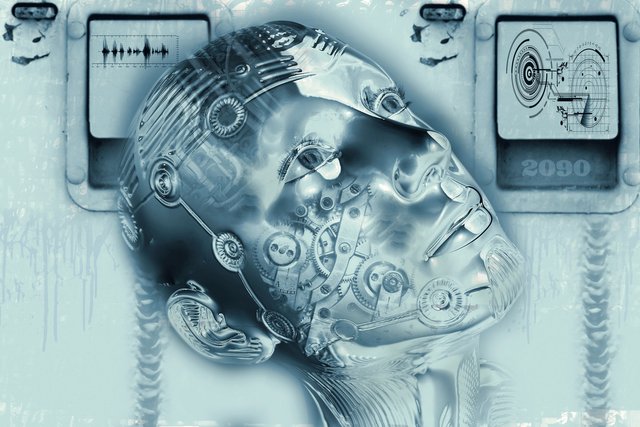The Revenge of the Cyborgs
If the rise of the machines is not some future apocalypse but an already lived past, then what time are we living in now? This is the question that I tackle in this next section. We've been responding to the impact of automation as a civilization for the past couple hundred years. But with the rise of information and voice technologies such as Amazon Alexa, Google Home, Apple Siri, or Microsoft Cortana, never before has the entirety of human knowledge and connection been so instantaneously available at our literal spoken command.
Whereas mainstream punditry might prefer to focus automation's influence on economic displacement, the Internet has empowered the disaffected with new means to organize economically and politically. Smartphone-connected humans are not awaiting a so-called future 'rise of the machines,' but are indeed living a present revenge of the cyborgs, and we are only now barely beginning to understand what it means to be human in globally hyper-connected civilization.
The full essay, "Will Robots Want to Vote? An Investigation into the Implications of Artificial Intelligence for Liberty and Democracy," was written as part of a fellowship for The Fund for American Studies Robert Novak Journalism Program. For an introduction to the premise of the project, please read my speech, Will Robots Want to Vote? For an introductory summary to the final essay, please read, This will begin to make things right. The project is presented as a multi-part series. This piece is Part 5. Please see the related posts linked at the bottom of this essay to read more of the project. If you liked this post, please consider sharing, commenting, and upvoting. Thank you in advance. - Josh Disclosure: This article contains Amazon Associates affiliate links. ---
The Cyborg
Given the historical context, and that various forms of artificial intelligence already exist and are in common usage through various companies such as Google, Facebook, Amazon, and Apple, our increasing reliance on A.I. suggests an alternative metaphor is needed. An organism that is part machine and part organic --- the cybernetic organism, or cyborg --- best fits this description.
Famous examples of cyborgs found in science fiction range from Darth Vader and RoboCop to Iron Man’s Tony Stark, Neo from The Matrix, the Borg in Star Trek, and Inspector Gadget. These characters convey a range of combinations of human and machine, but they depend on both sides of themselves, the organic and the machine, to survive.
Science fiction depicts these characters in extreme fashion, yet simple observation reveals modern humans who are immensely dependent on machines like cars, smartphones, and even physical prosthetics.
Whereas the Industrial Revolution was an attempt to augment our physical limitations, the current Information Revolution was built around the idea of augmenting our cognitive and communication limitations. The smartphone, for example, acts as a prosthesis for the human mind.
Current political and economic anxieties might have their parallels in history, but the invention of the Internet, smartphones, and social networking technologies magnify these emotions by collapsing time and space for their users.
Cyborg anthropologist Amber Case famously advances this thesis in her January 2011 TED Talk, “We are all cyborgs now.”
“What does the inside of your computer actually look like? Well, if you print it out, it looks like a thousand pounds of material that you're carrying around all the time. And if you actually lose that information, it means that you suddenly have this loss in your mind, that you suddenly feel like something's missing, except you aren't able to see it, so it feels like a very strange emotion,” said Case.
This newly externalized sense of self has changed the way we interact with the world and how we view ourselves, and our culture of constant connection to these technologies might more appropriately be considered an addiction.
If someone were to broach the topic of Internet and smartphone addiction in casual conversation 5-10 years ago, however, chances are it’d be laughed off as a joke or an alarmist headline. Nowadays, the issue is taken more seriously as smartphone ownership and membership on social networks increases.
A Pew Research Center study published in 2015, for example, found that nearly two-thirds of Americans own a smartphone, and use them for health and education-related activities, following the news, and communicating with loved ones.
A 2016 poll conducted by Common Sense Media, a family focused media and technology policy nonprofit, found that 50 percent of teens “feel addicted to their mobile devices,” but 78 percent check their devices at least hourly. Only 27 percent of parents surveyed said they felt addicted to their smartphones, but 69 percent said they checked their phone at least once an hour.
“Smartphones matter partly because of their ubiquity,” wrote The Economist in 2015. “They have become the fastest-selling gadgets in history, outstripping the growth of the simple mobile phones that preceded them. They outsell personal computers four to one. Today about half the adult population owns a smartphone; by 2020, 80% will.”
---
A Metaphor
Tech billionaire Elon Musk has said that humans must merge with machines to be competitive with artificial intelligence, but the cyborg metaphor suggests we are already well on our way and have been for some time.
Whereas Karl Marx, the 19th century philosopher, saw the relationship between humans and machines as a competitive paradigm, Case sees the relationship as more complimentary; she defines the cyborg as a “symbiotic fusion of human and machine.”
Case’s thesis is built on the philosophical foundations laid by Donna Haraway’s influential essay, "A Cyborg Manifesto: Science, Technology, and Socialist-Feminism in the Late Twentieth Century,” published in 1985.
“By the late twentieth century, our time, a mythic time, we are all chimeras, theorized and fabricated hybrids of machine and organism: in short, we are cyborgs,” wrote Haraway.
For Haraway, human-machine hybrids are but one type of cyborg; the image extends to all animal-machine hybrids, and the creature’s blurred boundaries serve as a postmodern subversion to classical Western gender norms. Her work is as much a socialist critique of traditional feminism as it is of masculinity and techno-capitalism.
Author Erik Davis explores this idea further in his book, TechGnosis: Myth, Magic, and Mysticism in the Age of Information, published in 1998.
“With pills modifying personality, machines modifying bodies, and synthetic pleasures and networked minds engineering a more fluid and invented sense of self, the boundaries of our identities are mutating as well,” said Davis.
Haraway’s reference to the chimera, a hybrid fire-breathing monster found in Greek mythology, however, is a curious one. Chimeras were considered by the Ancient Greeks to be disaster omens. The cyborg is a metaphor to destroy old cultural paradigms.
For Davis, our new information technologies are still evolving and hardly apocalyptic; we have yet to see what changes they will bring with them.
---
Revenge
The information technologies of our era are neither inherently good nor evil, but their use dictates whether a person might be empowered or harmed by them. When Johannes Gutenberg invented the printing press in 1440, for example, he sparked an information explosion whose effects are still with us to this day.
Internet technologies, whose impact have been likened to the invention of the printing press, allow people who have been expected to act like and closely work alongside of machines to self-organize economically and politically in radically new ways.
Similar notions about the impact of information technology also existed during the nation’s Founding era. The 18th century American Revolutionary War historian David Ramsay wrote in 1789 that “in establishing American independence, the pen and press had merit equal to that of the sword.”
Todd Andrlik, in a 2012 article for the Huffington Post, likened the impact of social media on the Arab Spring to that of newspapers and the printing press on spurring the Thirteen Colonies to war.
“Through vivid eyewitness accounts, battlefield letters and official dispatches, American Revolution era newspapers were filled with raw, breaking news, full of intense action, drama and suspense,” said Andrlik, author of Reporting the Revolutionary War: Before It Was History, It Was News.
Without the Internet, the smartphone still possesses many powerful computing and sensor capabilities, but it is the immediate access to the global Agora, the digital town square, that gives them their true power.
And just as the smartphone is more than simply an electronic newspaper, the Revolutionary era newspaper was more than just a mass-produced piece of inked paper. They were important nodes for aggregating social information that traveled across complex networks.
For all his many talents, Benjamin Franklin was a printer by trade who understood the power of the printing press, identity, and networks. In a 2013 TED Talk, Catherine Bracy, the former director of community organizing at Code For America, called Franklin “one of the greatest hackers of all time.” If Franklin were alive and active today, we might think of him as a political hacktivist.
In his 2013 essay, State Secrets: Ben Franklin and WikiLeaks, Russ Castronovo, an American Studies professor at the University of Wisconsin-Madison, describes the 18th Century courier networks with a familiarity that resembles how information spreads across online social networks.
“With its public sharing and unauthorized exposure of private letters, its pirated editions of quick production of pamphlets, its reprinting and plagiaries, all encouraging more writing and printing, the printscape of early America prefigures a contemporary mediascape with its propagation of threads, links, and digital nodes,” wrote Castronovo.
Yet even here, besides the obvious gulf in speed and connectivity, the differences between the networks of then and now are owed to the Industrial Revolution and the subsequent technological advancements that followed the birth of the nation. Now printing presses have minds of their own.
Dr. Anatoliy Gruzd, a professor at Ryerson University in Toronto, in his essay, Who are We Modelling: Bots or Humans?, describes the challenges that automated social media accounts, or bots, and algorithmic-filtering pose to social science researchers, given that these programs can not only influence the very human behavior researchers are attempting to study, but social scientists might not know how to account for this influence in their analysis.
By mining social media data without accounting for the influence of behavioral software, social scientists have become unwitting cyborg researchers.
---
Democracy
The question then becomes not necessarily whether American democracy can handle the development and advancement of artificial intelligence, but whether American democracy is built for cyborgs. In the face of the current propaganda-driven outrage culture, the answer should be a resounding yes.
Propaganda is not new, and the Constitutional system of checks and balances was designed to also be a check on the irrational passions of mob rule. But this new paradigm is not without its challenges.
The “narrow A.I.” software embedded into our social media and search technologies is impacting political discourse and election outcomes by further blurring the formerly stark delineations between humans and machines.
While conservatives might be uncomfortable with Haraway’s socialist-feminist ideological leanings, more than 30 years later her invocation of the chimera appears prophetic.
The National Intelligence Council report --- which attempted to assess how current political, economic, and technological trends might shape the world over the next 20 years --- mentions artificial intelligence 14 times, usually within the context of the future of work. But it also suggests social media and algorithmic filtering of online content will make diplomacy and governance increasingly more difficult.
“It will be much harder to cooperate internationally and govern in ways publics expect. Veto players will threaten to block collaboration at every turn, while information ’echo chambers‘ will reinforce countless competing realities, undermining shared understandings of world events,” said the report.
The relationship between the tendency to seek out people and content that confirm our pre-existing biases, or homophily, and social media been written about extensively. And given the effect the rise of social bots and algorithmic filtering has on the public’s ability to discern fact from fiction and its impact on future elections, the designers of these programs at times resemble Johann Wolfgang von Goethe’s “sorcerer’s apprentice.“
Goethe’s poem by the same name, written in 1797, which is depicted in Disney’s animated classic, Fantasia, is a story in which the bored apprentice of an old sorcerer tries to use magic to help him finish his chores but is quickly overwhelmed by the unintended consequences created by his lack of magical knowledge.
---Thank you for reading,
- Josh
---Further Reading
* Hull, Gordon. "Know thy Cyborg-Self: Thoughts on Socrates and Technological Literacy." The Nature of Technology, 2013, 15-34. Accessed December 21, 2017. doi:10.1007/978-94-6209-269-3_3.
* Asenbaum, Hans. "Cyborg activism: Exploring the reconfigurations of democratic subjectivity in Anonymous." New Media & Society, March 28, 2017. Accessed December 20, 2017. http://journals.sagepub.com/doi/abs/10.1177/1461444817699994.
* Prospero. "The controversial bit of “Ghost in the Shell” is also its most original." The Economist. March 31, 2017. Accessed December 20, 2017. https://www.economist.com/blogs/prospero/2017/03/cyborgs-and-censure.
* Vidart-Delgado, Maria L. "Cyborg political machines." HAU: Journal of Ethnographic Theory 7, no. 2 (August 2017): 255-77. Accessed December 21, 2017. doi:10.14318/hau7.2.027.
* Syeed, Nafeesa. "Pro-Russian Bots Sharpen Online Attacks for 2018 U.S. Vote." Bloomberg.com. September 01, 2017. Accessed December 21, 2017. https://www.bloomberg.com/news/articles/2017-09-01/russia-linked-bots-hone-online-attack-plans-for-2018-u-s-vote.
* Greenham, Tony. "Let's embrace AI, but first we need to reboot economic democracy." RSA 21st century enlightenment. October 24, 2017. Accessed December 21, 2017. https://www.thersa.org/discover/publications-and-articles/rsa-blogs/2017/10/lets-embrace-ai-but-first-we-need-to-reboot-economic-democracy.
* Holland, James, and Erin Gallagher. "Solecast: Erin Gallagher on Hacking Public Opinion, Twitter Bots & Cyborgs." SOLE. October 30, 2017. Accessed December 21, 2017. http://www.soleone.org/solecast/2017/10/30/solecast-erin-gallagher-on-hacking-public-opinion-twitter-bots-cyborgs.
* Lilly, Paul. "Google AI Futurist Envisions Human Cyborg Uprising Within 20 Years." HotHardware. November 13, 2017. Accessed December 21, 2017. https://hothardware.com/news/google-ai-futurist-envisions-human-cyborg-uprising-within-20-years.
---Related Posts by Josh Peterson
* "Robot Law." Steemit. November 6, 2017. Accessed December 20, 2017. https://steemit.com/artificial-intelligence/@joshpeterson/robot-law
* "Raging Against the Machines." Steemit. October 27, 2017. Accessed November 2, 2017. https://steemit.com/artificial-intelligence/@joshpeterson/raging-against-the-machines
* "The Rise of the Machines Has Already Happened." Steemit. October 25, 2017. Accesed November 6, 2017. https://steemit.com/artificial-intelligence/@joshpeterson/the-rise-of-the-machines-as-a-historical-metaphor
* "Rethinking Artificial Intelligence." Steemit. October 22, 2017. Accessed October 24, 2017. https://steemit.com/artificial-intelligence/@joshpeterson/rethinking-artificial-intelligence
* "This will begin to make things right." Steemit. October 22, 2017. Accessed October 22, 2017. https://steemit.com/writing/@joshpeterson/this-will-begin-to-make-things-right.
* "Will Robots Want to Vote?" Steemit. October 19, 2017. Accessed October 22, 2017. https://steemit.com/artificial-intelligence/@joshpeterson/will-robots-want-to-vote.
View Post History

Congratulations! This post has been upvoted from the communal account, @minnowsupport, by joshpeterson from the Minnow Support Project. It's a witness project run by aggroed, ausbitbank, teamsteem, theprophet0, someguy123, neoxian, followbtcnews/crimsonclad, and netuoso. The goal is to help Steemit grow by supporting Minnows and creating a social network. Please find us in the Peace, Abundance, and Liberty Network (PALnet) Discord Channel. It's a completely public and open space to all members of the Steemit community who voluntarily choose to be there.
If you would like to delegate to the Minnow Support Project you can do so by clicking on the following links: 50SP, 100SP, 250SP, 500SP, 1000SP, 5000SP. Be sure to leave at least 50SP undelegated on your account.
If Control Freaks try to get us, should be buy robot body guards?